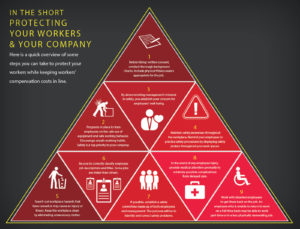Compensation control
You can protect your workers … while keeping workers’ compensation costs in line.
If you’re a typical marine-fabrication business owner, workers’ compensation costs—or the threat of them—can quickly become a major expense burden. Almost every business in the United States that has employees must deal with the cost of workers’ compensation; it’s a perennial issue, but needs annual attention.
There are steps you can take to help keep your workers’ comp costs under control while lessening the chances of a costly and burdensome claim. But keep in mind that employers who have successfully cut their workers’ compensation costs report it is a challenging task requiring attention and ongoing commitment from management.
Perhaps most important is an understanding that policies designed to protect employee safety and well-being provide a solid foundation for minimizing workers’ compensation claims. Experience shows that employees who feel that worker safety is a major concern of management are less likely to attempt to abuse the workers’ compensation system.
 Smart hiring comes first
Smart hiring comes first
Here are some steps you can take to help control workers’ compensation claims and insurance premiums:
- 1. After obtaining written consent from the applicants, conduct thorough background checks before hiring. Include physical fitness exams appropriate for the job if included in the written consent. Applicants who are reluctant to agree to such checks should be investigated thoroughly.
- 2. Have permanent programs in place to train employees on the safe use of equipment and safe working behavior. Discourage unsafe working habits. Instruct employees not to take risks. Encourage the safest procedures even if they may take longer. Make sure that new workers are aware that workplace safety is a top priority in your company.
- 3. By demonstrating management’s interest in safety, you establish your concern for employees’ well-being while helping to minimize the possibility of costly workers’ compensation claims.
- 4. Maintain safety awareness throughout the workplace. Remind your employees to practice safety procedures by displaying safety posters throughout your work spaces. Within legal parameters, develop and include programs designed to keep your workplace drug- and alcohol-free. Failure to address these issues might be considered by some as a lack of interest or concern.
- 5. Search out workplace hazards that have caused or may cause an injury or illness. For example, look for situations that may cause the very common and always dangerous trip-and-fall accidents. Keep the workplace clean by eliminating unnecessary clutter.
- 6. Be sure to correctly classify employee job descriptions and titles. Some jobs are riskier than others; an office clerk works in a less risky environment than a shop worker. With more than 600 job classification codes in use today, improper job classification for even one employee could increase your workers’ compensation premiums. Each classification code is based on the level of risk associated with that job. Job codes are subject to change, so it’s important to use the most recent edition of the classification codebook for your state.
Some business owners intentionally misclassify workers and manipulate payroll figures with the intent of lowering insurance costs. Even worse are situations in which employers have no workers’ compensation coverage at all. Employers who engage in this type of activity not only put their workers in danger, but also risk harsh financial penalties and even prison time. - 7. If your company is large enough, establish a safety committee made up of both employees and management. The committee’s purpose will be to identify and correct safety problems, provide ideas for improving the company’s safety programs, and prepare safety instructions for distribution to employees.
- 8. In the event of any employee injury, provide medical attention promptly to minimize possible complications from delayed care. Complications to even a slight injury can result in increasingly costly workers’ compensation claims, which in turn can result in permanently increased insurance premiums.
- 9. Work with disabled employees to get them back on the job as quickly as practical. An employee who is unable to return to work on a full-time basis may be able to work part-time or in a less physically demanding job. The longer an employee remains unable to work, the more the insurance company will be required to pay in compensation benefits, which leads to higher premiums for the employer.
Many employers look on the costs of workers’ compensation insurance as an unavoidable expense over which they have little or no control. Experience shows, however, that workers’ compensation costs will respond to dedicated efforts to keep them contained. A determined and continual effort can result in not only major reductions in expense, but dramatic improvements in employee morale as well.
William J. Lynott is a business writer based in Rydal, Pa.
A fair exchange
Workers’ compensation is a form of insurance providing wage replacement and medical benefits to employees injured in the course of employment, in exchange for the employee’s right to sue an employer for negligence. The intent is to eliminate the need for litigation by having employees give up the potential for pain and suffering-related awards in exchange for not being required to prove legal fault on the part of the employer.
In the United States, the first statewide worker’s compensation law was passed in Maryland in 1902. By 1949, all states had enacted some kind of workers’ compensation regime. At the turn of the 20th century these laws were voluntary, but after a Supreme Court ruling in 1917, most states enacted new compulsory workers’ compensation laws.
 TEXTILES.ORG
TEXTILES.ORG 






